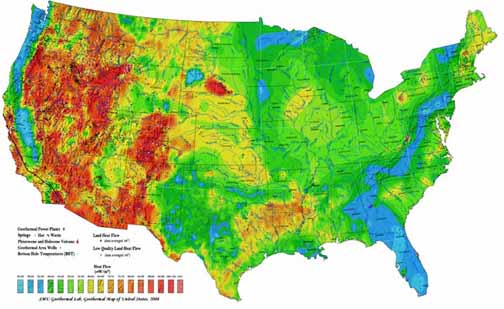
Barriers to Increased Use of Geothermal Energy in the U.S.
 |
| 2004 Surface Heat Flow Map from the Southern Methedist Universtiy Geothermal Lab. |
The United States Geological Survey (USGS) estimates that the U.S. has the resource potential for 60,000 megawatts of thermal energy (MWt). Currently, GDHS makes up about one sixth of total direct use. Extrapolating this ratio to the full potential would amount to approximately 10,000 MWt of district heating (Thorsteinsson 2008, 32). Expanding GDHS from100 MWt, the approximate current U.S. capacity, to 10,000 MWt would provide heat to approximately two million people and reduce the nation’s CO2 emissions from space and hot water heating by about 1%. A successful establishment of EGS, enabling expansion to 100,000 MWt, would reduce the emissions from space and water heating by about 9% nationally (Thorsteinsson 2008, 114). The GDHS industry is perceived as mature by federal regulators and therefore federal geothermal policy does not provide support for direct uses such as GDHS. Barring a significant change in federal policy, government funding for GDHS will have to come directly from the states.
A geothermal lease is needed in order to exploit a geothermal resource. Leases are between the developer and either the federal or state government. About half of the nation’s geothermal resources are on federal land. Historically the Bureau of Land Management (BLM) has been ill equipped to process federal geothermal leases. Because of a lack of dedicated staff and funding for processing federal geothermal leases, and due to concerns over liability, a major backlog developed at the BLM. In California in 2006 no leases had been issued over the past twenty years (Thorsteinsson 2008, 101). The Energy Policy Act of 2005 included measures to streamline the federal leasing process, which hopefully will relieve the bottleneck in the coming years. Statutes for state leases vary by state.
Another barrier is the lack of statutory authority granted to towns and cities. Generally towns and cities must be granted authority by the state before they can develop geothermal district heating systems (Thorsteinsson 2008, 103). Regulations regarding public utilities apply to geothermal district heating systems in many states and can create administrative barriers for small GDHS projects. There is also a need for more detailed data on geothermal resources. Between 1978 and 2006 there was no geothermal evaluation program at the United States Geological Survey, whose 1978 survey constitutes some of the best data available to developers. Unfortunately, the new assessment completed in 2008 focused on moderate and high-temperature resources for power production and did not include a new evaluation for low temperature direct uses.
Geothermal heat pumps face fewer barriers than district heating systems and power plants. High up-front capital costs are a primary barrier to wider use of geothermal heat pumps. A lack of trained installers is also a significant barrier in some parts of the country and further raises installation costs. Each site has to be evaluated to determine the suitability of a geothermal heat pump project. Installation‐specific design and engineering of the ground loop are usually required. This is not the case with conventional heating systems. Space requirements for ground coupling can be problematic in densely built areas. Depending on the jurisdiction, and particularly in the urban setting, special permits may be needed before completing a project.